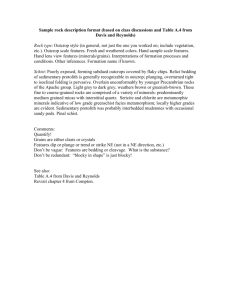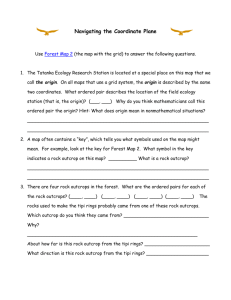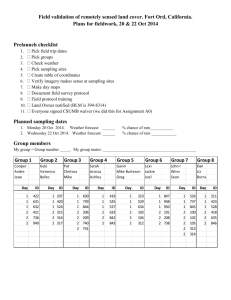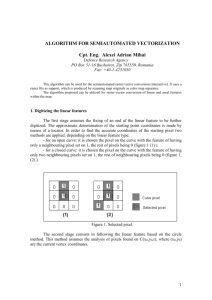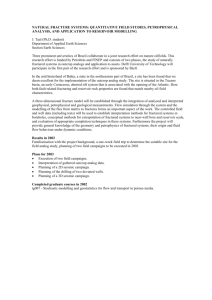Using 3D Analyst to drape images on vertical terrain surfaces
advertisement
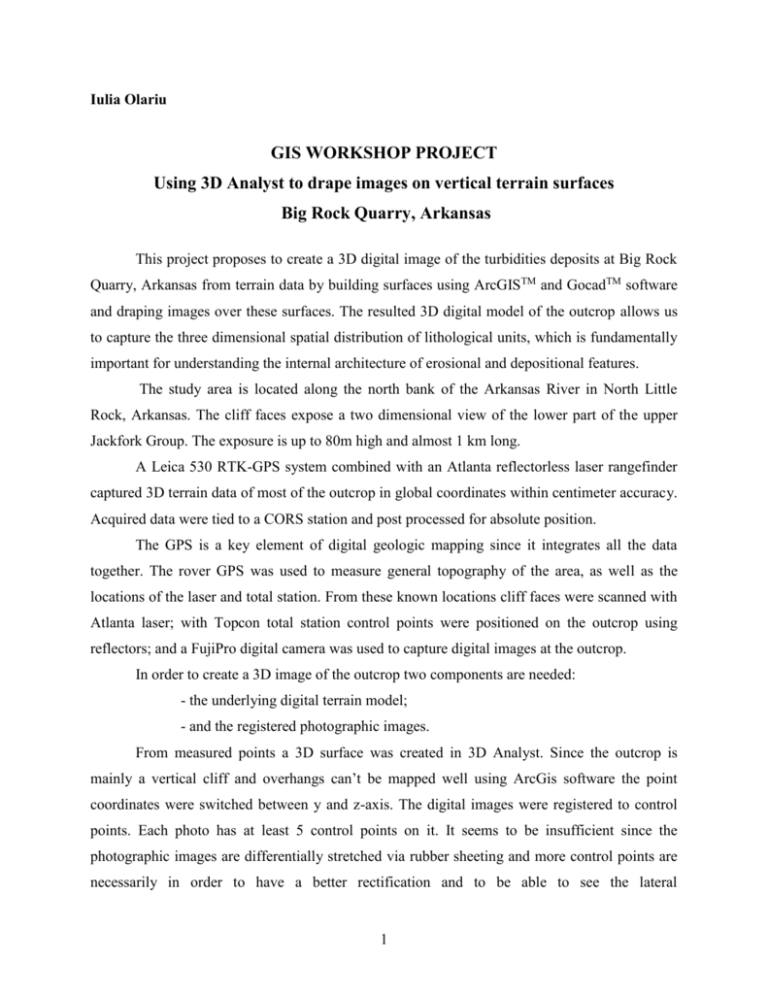
Iulia Olariu GIS WORKSHOP PROJECT Using 3D Analyst to drape images on vertical terrain surfaces Big Rock Quarry, Arkansas This project proposes to create a 3D digital image of the turbidities deposits at Big Rock Quarry, Arkansas from terrain data by building surfaces using ArcGISTM and GocadTM software and draping images over these surfaces. The resulted 3D digital model of the outcrop allows us to capture the three dimensional spatial distribution of lithological units, which is fundamentally important for understanding the internal architecture of erosional and depositional features. The study area is located along the north bank of the Arkansas River in North Little Rock, Arkansas. The cliff faces expose a two dimensional view of the lower part of the upper Jackfork Group. The exposure is up to 80m high and almost 1 km long. A Leica 530 RTK-GPS system combined with an Atlanta reflectorless laser rangefinder captured 3D terrain data of most of the outcrop in global coordinates within centimeter accuracy. Acquired data were tied to a CORS station and post processed for absolute position. The GPS is a key element of digital geologic mapping since it integrates all the data together. The rover GPS was used to measure general topography of the area, as well as the locations of the laser and total station. From these known locations cliff faces were scanned with Atlanta laser; with Topcon total station control points were positioned on the outcrop using reflectors; and a FujiPro digital camera was used to capture digital images at the outcrop. In order to create a 3D image of the outcrop two components are needed: - the underlying digital terrain model; - and the registered photographic images. From measured points a 3D surface was created in 3D Analyst. Since the outcrop is mainly a vertical cliff and overhangs can’t be mapped well using ArcGis software the point coordinates were switched between y and z-axis. The digital images were registered to control points. Each photo has at least 5 control points on it. It seems to be insufficient since the photographic images are differentially stretched via rubber sheeting and more control points are necessarily in order to have a better rectification and to be able to see the lateral 1 continuity/discontinuity of lithological units. Seven photos were used to represent the outcrop and it seems that 3D Analyst can hardly manage such an amount of data. In ArcGis images are stored as raster data, where each cell in the image has a row and column number, whereas shapefiles are stored in real-world coordinates. In order to display images with shapefiles it is necessary to convert the image coordinates to real-world coordinates. This information is stored in a separate ASCII file “.tfw file” associated with the registered image. This file is generally referred to as the world file, since it contains the real-world transformation information used by the image. The following summarizes the content of the world file: Line1: x dimension of a pixel in map units (A) Line2: rotation parameter (D) Line3: rotation parameter (B) Line4: NEGATIVE of y dimension of a pixel in map units (E) The y scale is negative because the origins of an image and a geographic coordinate system are different. The origin of an image is located in the upper left corner, whereas the origin of the map coordinate system is located in the lower left corner. Line5: translation parameter; x coordinate of center of upper left pixel (C) Line6: translation parameter; y coordinate of center of upper left pixel (F) The image-to-world transformation is in the form of: X = Au + Bv + C Y = Du +Ev + F Where, X = calculated x coordinate of the pixel on the map Y = calculated y coordinate of the pixel on the map u = column number of a pixel in the image v = row number of a pixel in the image The transformation information was used to find the corresponding x and y coordinates for each pixel in each digital photo in order to see how the images are displayed in both software ArcGis and Gocad. 2 Therefore the digital images of the outcrop were also draped on a terrain surface built in Gocad. The preliminary steps are the same as above - GIS software is used for real time data collection and visualization in the field, rectification of photographic images and manipulation of 3D points from the outcrop, but the process of building a surface in Gocad takes in consideration some constraint directions that allow the surface to be built after an optimum direction. The x and y coordinates for each pixel on the photo draped over the Gocad surface were extracted in order to compare them with the x and y coordinates for the same photo draped over a GIS surface. The differences were greater at the edge of the images and far away from control points. Around control points the x and y coordinates for the same pixel were almost the same since after rectification tic points are on average closer to ground control points, but not identical. The differences between any two pictures were higher in the direction of x-axis (mean = -1.22 m, std = 2.8) compared to y-axis (mean = -0.012 m, std = 0.44). This means that more control points are necessarily in order to have a better rectification, as well as, a higher density of terrain data from which the surface will be built. The picture is draped over a TIN surface, therefore the denser the points, the more accurate the surface. In conclusion we can say that there are some advantages of using GIS software in building 3D models of outcrops, as well as, some disadvantages. Advantages: GIS software is a very good tool for: • Real time data collection and visualization in the field • Registration of digital photos to control points • Manipulation and visualization of x, y, z points from the outcrop. Disadvantages: • GIS software can’t map well overhangs • More control points are necessarily in order to have a better rectification • GIS can hardly manage a great amount of data. The PowerPoint presentation related www.utdallas.edu/~mjx011000/GIS. 3 to this project can be found at Source of Data used in Presentation USGS: North Little Rock DEM (SDTS) – GCS_North_American_1927 (NAD 1927 UTM Zone 15N) Geography Network, Census 2000 TIGER Files: Tgr05119lkA.shp - GCS_Assumed_Geographic_1 Tgr05119lkH.shp - GCS_Assumed_Geographic_1 Tgr05119wat.shp - GCS_Assumed_Geographic_1 Geography Network: Streams and Waterbodies in the United States Data Set - NAD 1983 (Decimal Degrees) State Boundaries of the United States Data Set - NAD 1983 (Decimal Degrees) County Boundaries of the United States Data Set - NAD 1983 (Decimal Degrees) Cities and Towns of the United States Data Set - NAD 1983 (Decimal Degrees) Roads of the United States Data Set - NAD 1983 (Decimal Degrees) MapQuest: Arkansas state and North Little Rock city aerial photos 4
